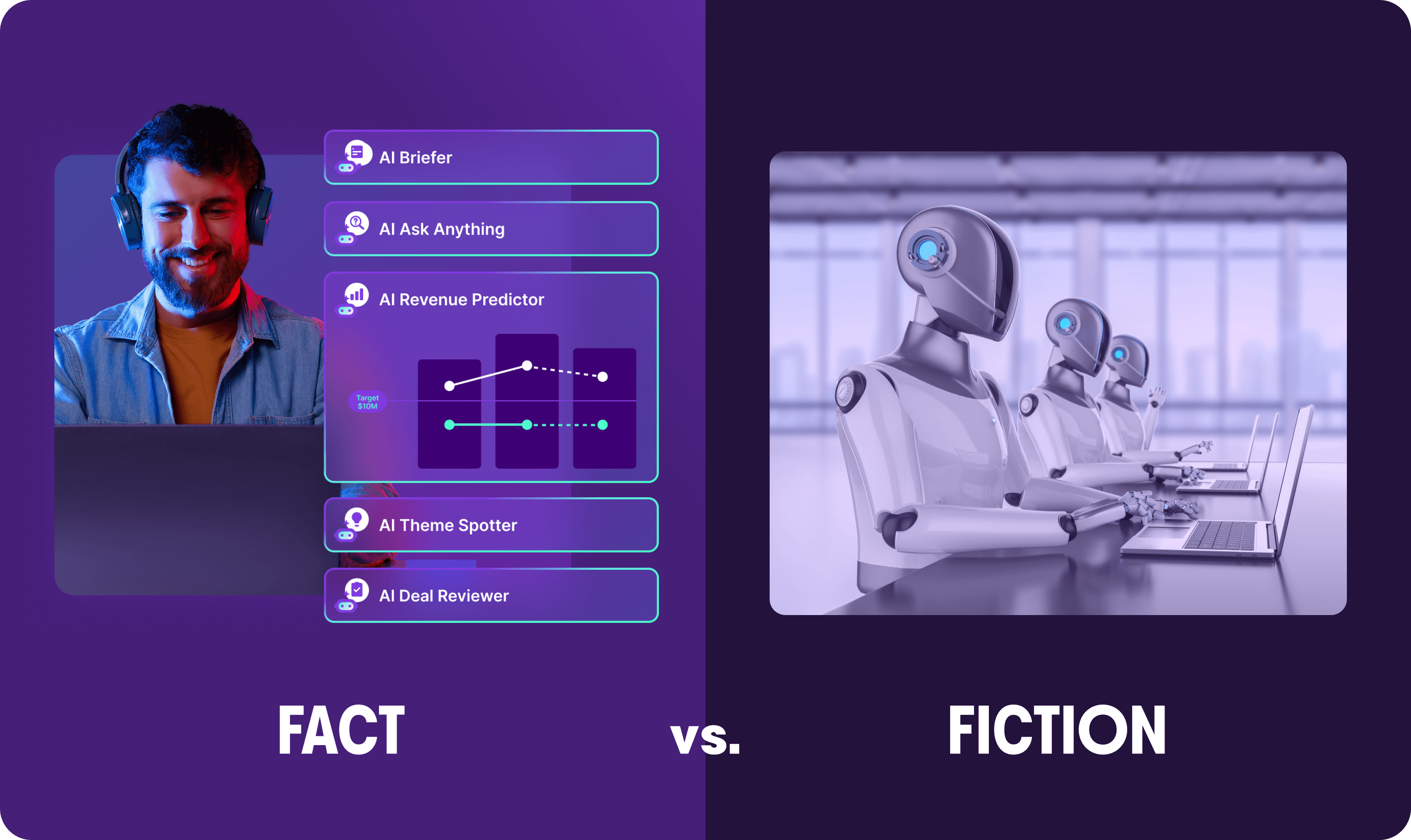Selling skills
Examples of 15 amazing sales tactics that win deals

Jil Beardmore
Content Author
Published on: May 13, 2019
Googlesales tacticsand you’ll get plenty of articles with solid offerings.
“Ask about pain points. Listen to your customer. Solve problems. Generate referrals.”
Yesto all those things.
And a massive YES tospecificsales tacticsbacked bydata. Like the ones from Gong.io.
They offer upprecise sales tactics, right down to the words you should (and shouldn’t) use at each stage of your sales process .
Why is Gong the reigning champ in this realm? Because the Gong Labs research team used AI to analyze more than 5 million sales calls and pinpoint the words that sell and phrases that close deals.
Here are 15 sales tactics to help you say the right thingevery time. They’re swimming in data, so you can seehowandwhythey work.
Let’s move from a cold call through to a closed deal.
Sales Tactic 1: State Your Full Name and Company Name
Important people state theirfullname. That’s true whether you meet them in person or on a cold call.
Why do they do it? It commands respect.Immediately.
The next time you connect with someone new, state your full name, then your company’s name so your buyer doesn’t have to ask for it.
That last bit is important because whoever asks the questions controls the conversation. Don’t let your buyer get the upper hand right off the bat.
Remember that the next time you make a call.
Open with your version of “Hi Andrea, it’s Dana Karos calling from Gong …”
Sales Tactic 2: Stop Saying “Did I Catch You at a Bad Time?”
Avoid timid and apologetic openers, especially “Did I catch you at a bad time?”
That phrase should have been put to bed ages ago, but it’s in enough sales books that new recruits still pick it up.
How did it get a toehold in sales? As the theory goes, people like to sayno. It makes them feel powerful. So when you ask, “Did I catch you at a bad time,” you elicit anoand open the door to a chat.
It’s a nice theory. It works in some situations ( like negotiations ), but it doesn’t work on cold calls .
In fact, Gong’s data shows that using it makes you 40% less likely to book a meeting:
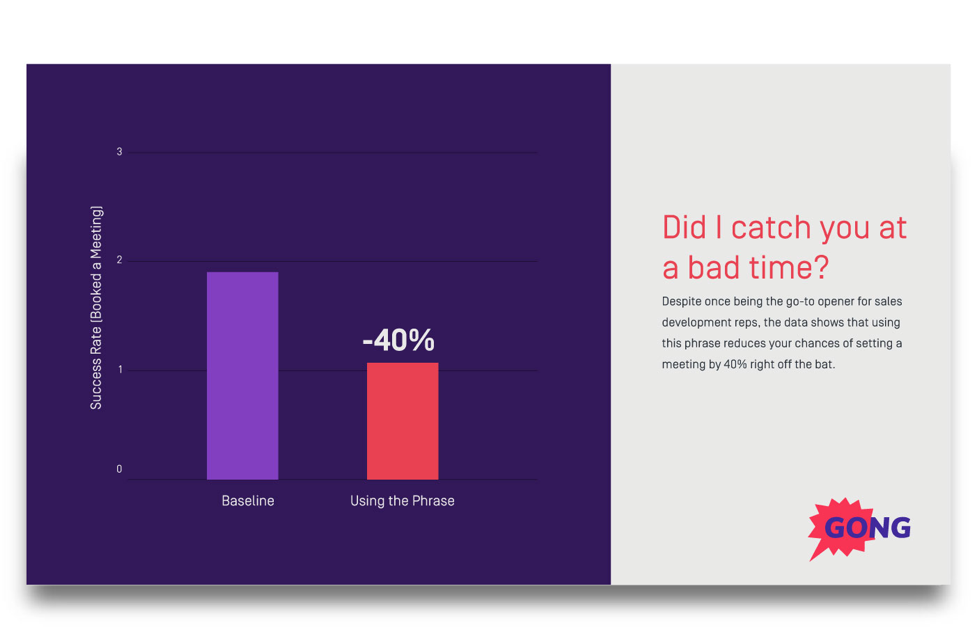
Luckily, there’s an alternative thatworks.
Read on.
Sales Tactic 3: Open with “How’ve You Been?”
Will you feel awkward asking someone ‘how they’ve been’ if you don’t know them?
Maybe. But even if you do, that feeling will pass when you realize how well it works.
Simply put, there’s no cold call opening line that works better.
It performs 6.6 times better than any other opening line:
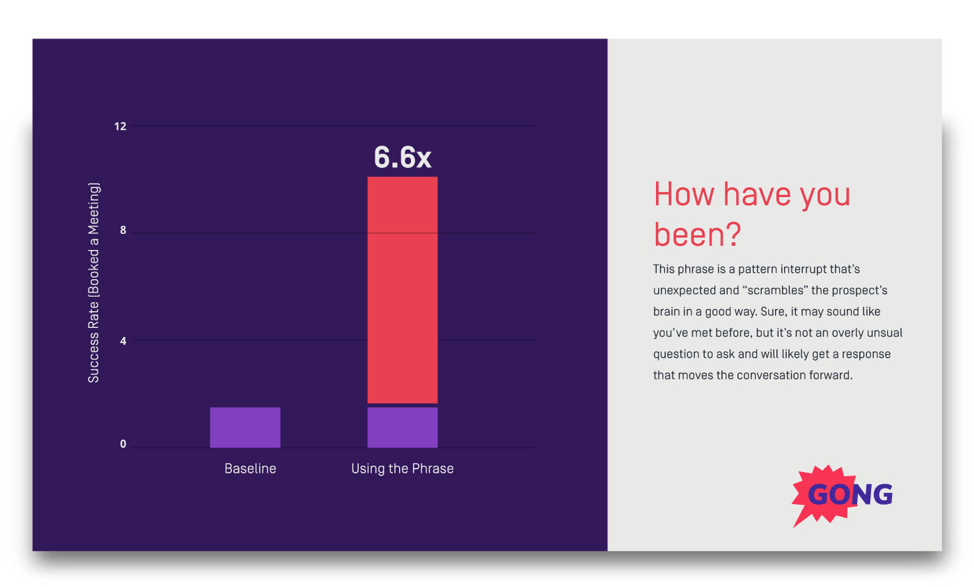
That data is fromfirst-interaction calls, so it’s a good predictor of how things should go if you use it on cold calls.
Sales Tactic 4: Say Why You’re Calling. ASAP.
The next phrase that should come out of your mouth is “The reason I’m calling is …”.
It gives you a 2.1x higher success rate than if you don’t say why you’re calling:
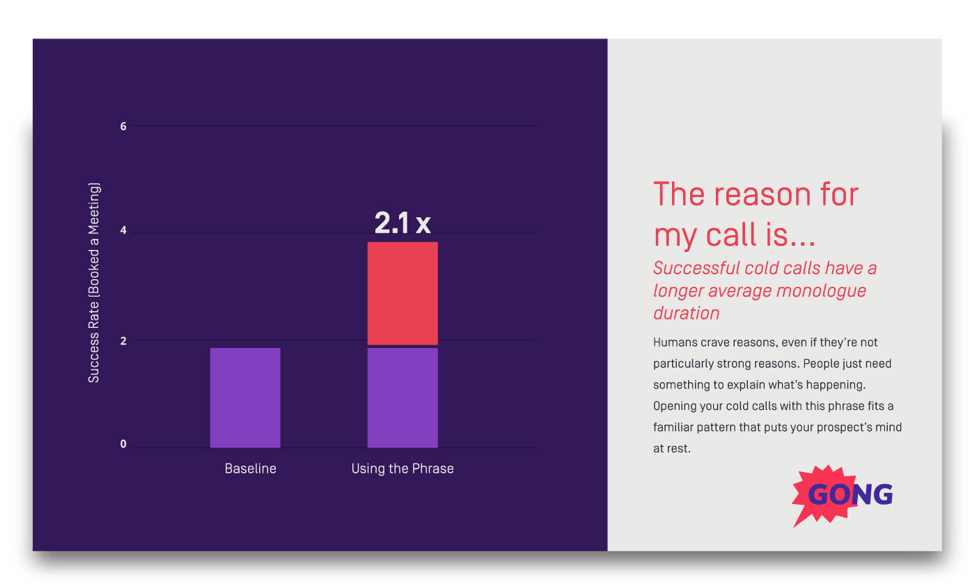
When people get a call from someone they don’t know, a tiny warning bell goes off inside them. Who is this? Why are they calling? What’swrong?
Put worries to rest as quickly as possible by following up on your full name, company name, and “How’ve you been?”, with the point of your call.
Sales Tactic 5: Book a Meeting Using This Question
Once you’ve primed your buyer for a meeting, there’s an easy way to book it. And it’s not by saying “Would you be open to meeting with us some time soon?”
When you’re ready to nail down a meeting, say this phrase: “Do you have your calendar handy?”
It’s an outstanding cold call closing tactic . Everyone can access a calendar in one click these days. Take them there.
Sidebar: If you’re not sure how to move a conversation from your opening line to the booking stage, Istrongly suggest you download this FREE cold calling cheat sheet.

Sales Tactic 6: Use Phrases That Evoke Long Answers
Congratulations. You’re into your discovery call .
Your approach for the rest of your sales process depends entirely on what you learn in this conversation, so get lots of information out of your buyer. That means getting the longest answer possible to every question you ask.
There’s a good argument for this sales tactic. There’s a direct correlation between your odds of closing a deal and the length of your buyer’s response to questions:
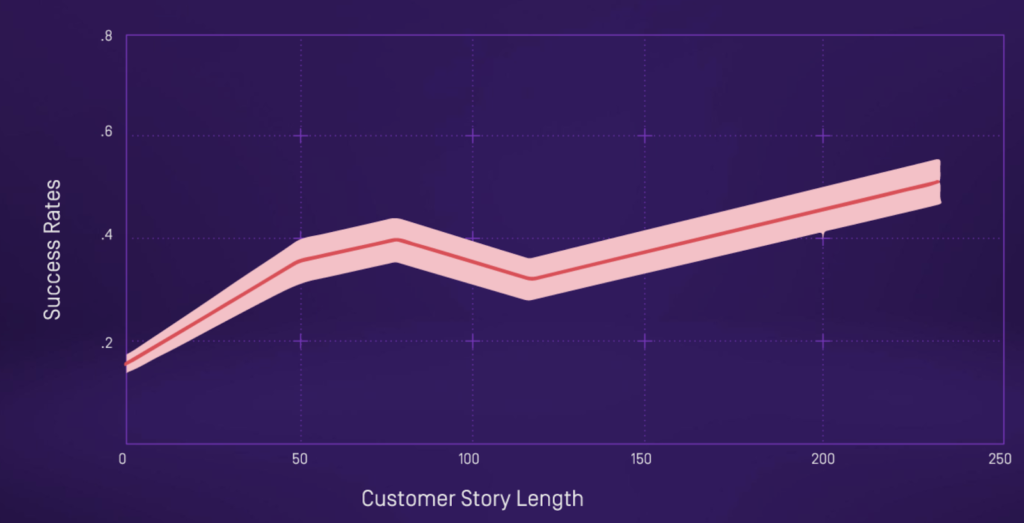
You want to elicit a long response from your buyer. A conversation that looks look like this:

How do you make sure that happens every time?
Phrase your questions in a way that encourages long responses. Start questions with one of these phrases:
- Can you help me understand …
- Can you walk me through …
- Can you talk to me about …
- Can you tell me about …
Don’t say: “What’s your biggest challenge?”
Instead, say: “Can you help me understand your biggest challenge?”
Not sure if your buyer’s answers are long enough? Measure them using Gong’s stats tab :
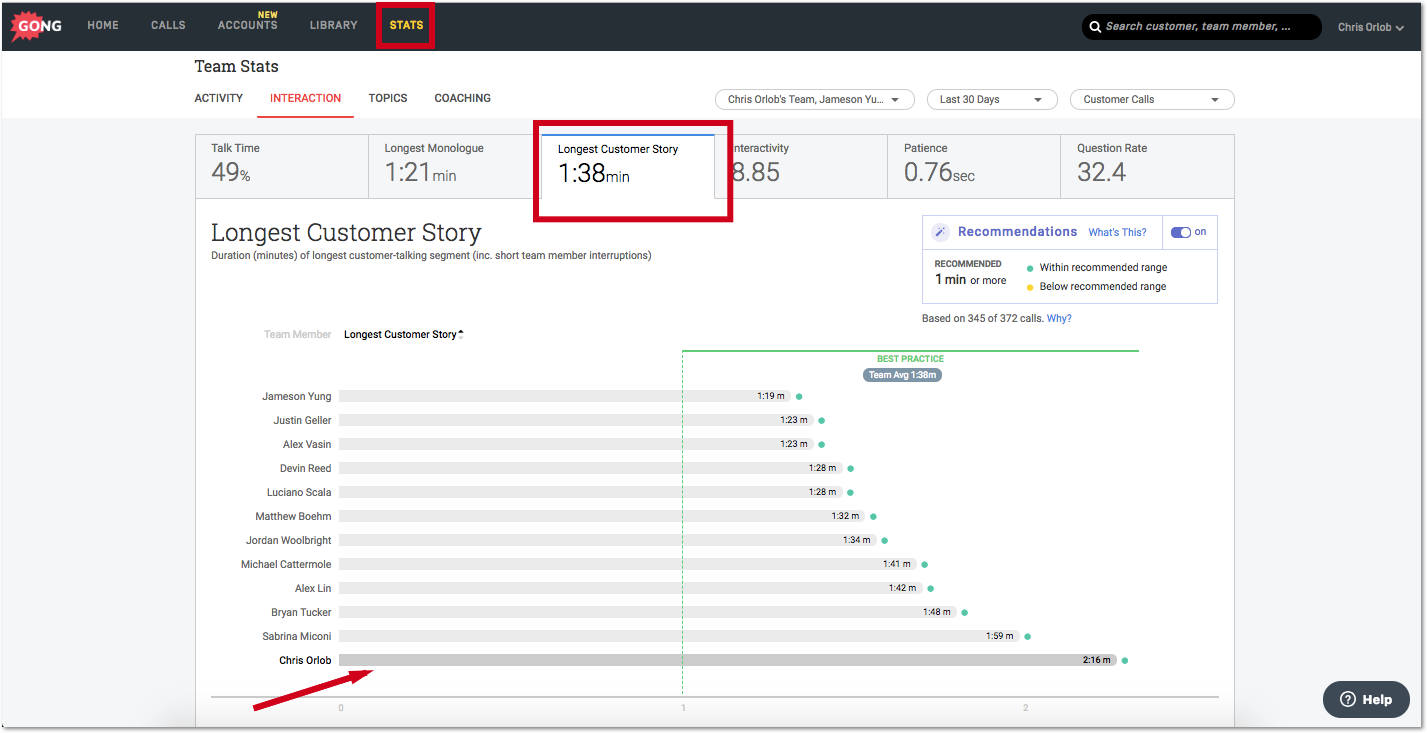
Sales Tactic 7: Handle Objections with Questions
You’re ready to demo your product.
Even if things go well, you’ll probably encounter objections. Don’t let them throw you.
Yes, they’ll take you in a new direction, but you’ll get incredibly valuable information if you handle objections properly by asking questions. It’s a sales tactic that helps you win deals.
The top reps ask questions 54.3% of the time when they hear an objection, compared with 31% for average sales reps:
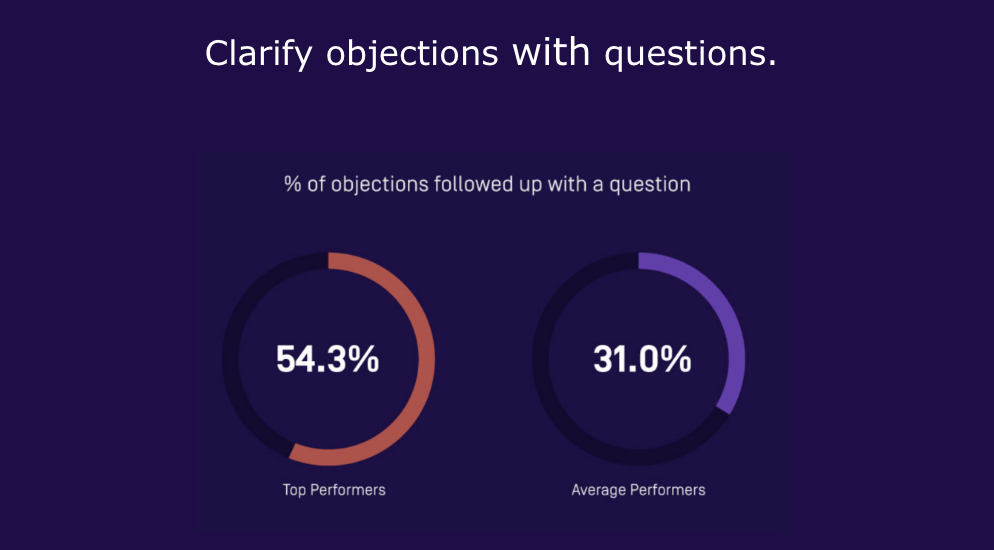
The purpose here is to avoid the knee-jerk verbal reaction that’s common to salespeople: pushing back on objections with a tornado of words.
Salespeople know and love their products, and want to defend them the second they hear doubts.
Bad move. Don’t drown out your buyer’s concerns with your own chatter about the benefits of your amazing product.
Ask questions that make your buyer feelheard.
It also gets them to reveal theirtruedoubts about your product and their root cause. These are the sticking points that could keep your buyer from sayingyes. They’re what you really need to understand.
PS: This Objection Handling Master Class is 100% worth your time:

Sales Tactic 8: What’s Changed since We Last Talked?
Once you’ve done your discovery session, it’s important to ask one question every time you meet with a buyer. It’s this: “What’s changed since the last time we talked?”
Change can happen at any point in your sales process. You can (andshould) prepare for meetings. But you don’t know what’s happening at your buyer’s organization while you’re in prep mode.
So find out. Do it at the top of your meeting so you don’t waste time addressing a situation that has shifted since your last meeting.
If things are status quo, proceed as planned. If they’ve changed, dig into that change right away to get key information and reset your approach. It’s no fun rejigging your strategy on the fly, but it’s better than finding out 30 minutes into a meeting that the sales environment has shifted.
Sales Tactic 9: Mirror the Buyer’s Most Important 1-3 Words
Know what sounds good to buyers?Their own words.
They’re the best way to get more information out of your buyer and keep your deal on track.
Here’s a sales tactic from Chris Voss on how to do this effectively:
When you need to hear more info from your buyer, repeat 1-3 of the main words from their last statement. Say them like you’re asking a question.
Here’s how that should play out:
- Buyer: Our product is strong, but our reps aren’t always clear about our differentiators. They tend to back peddle when customers ask how we’re different.
- Sales rep: Back peddle?
- Buyer: Yes. They don’t have a clear answer and they’re not consistent in how they answer.
- Sales rep: Not consistent?
- Buyer: Yes, that’s the real problem we’re dealing with. I have 70 sales reps who handle sales calls in 70 different ways. Their narratives don’t match up and their sale processes don’t either.
It’s the best sales tactic to get deeper information from your buyer and it’s more effective than asking them to expand on their last point.
Sales Tactic 10: Use This Sentence to Label Your Buyer’s Emotions
Here’s one more sales tactic from Chris Voss — a technique calledlabeling.
There’s an emotion behind everything your buyer says. If you can pinpoint it for them, you’ll earn HUGE bonus points and gain their trust.
Here are the phrases you should use:
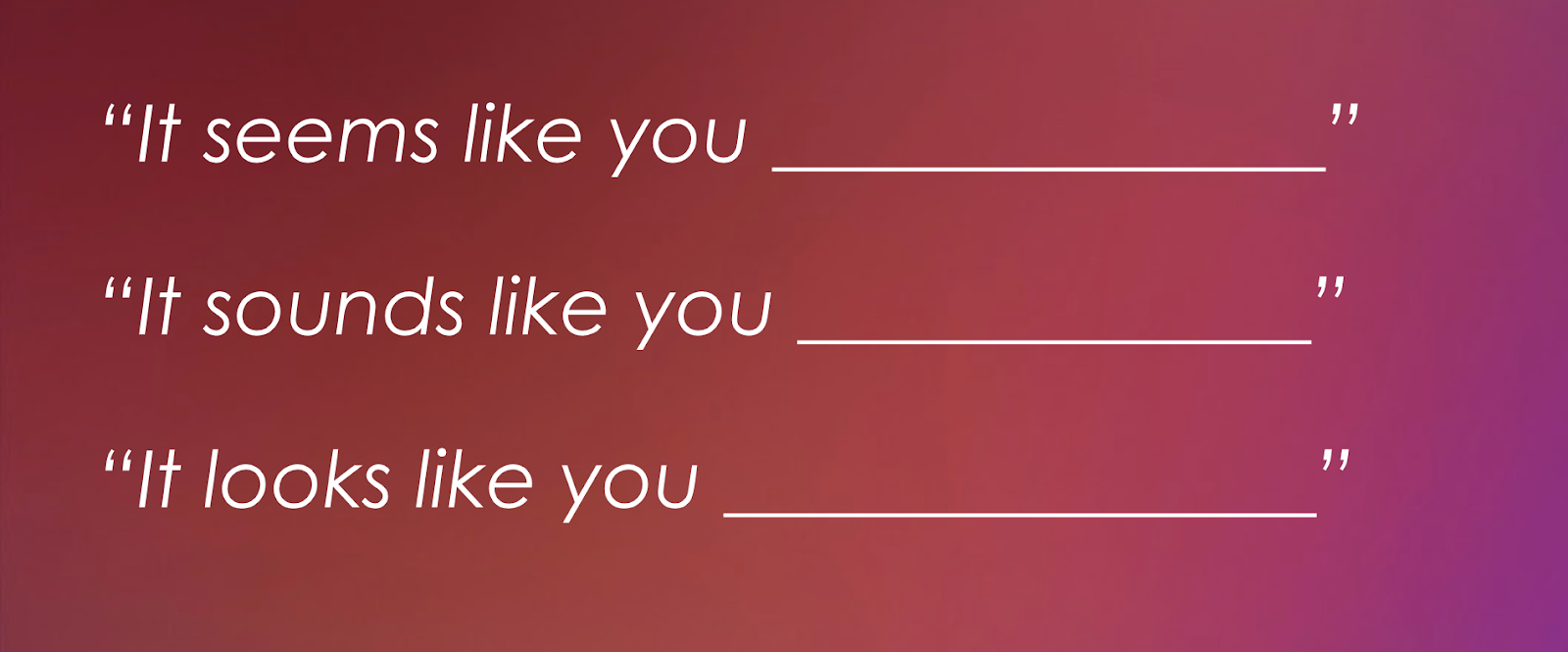
The blank space is for the emotion you observe in your buyer. A final version might sound like this:
- Buyer: It’s labor-intensive for us to onboard new sales reps. Creating the training material brings our enablement department to its knees.
- Sales rep: It sounds like you feel overwhelmed every time a new onboarding class starts.
Naming their emotion accurately will have brilliant results. You’ll open a door to a ton of valuable information. Your buyer will feel safe and understood, and will spill rich information.
Your job is to stop talking andlisten.
Sales Tactic 11: Use Executive-Level Language
Hopefully it’s clear by now that words and phrases help you close deals.
Here’s an unexpected way they do that:

Here’s what that means in practical terms: Focusing on specs and features gets you sent to the folks in IT, because they care about that kind of info. But that approach won’t get you into a senior executive’s office, where decision making happens.
Why not? Because executive language focuses onstrategic issues. You have to use that type of language if you want a shot at being pushed upstream to them. That means focusing on broader business problems and opportunities. Talk competition, market, and trends, and you’re on your way to selling to the C-suite .
Here’s a FREE training video on selling to the C-suite:

Sales Tactic 12: Validate Their Objection
Here’s another sales technique on naming a buyer’s emotion. And if you do it correctly, your buyer will feel understood, which is the best way to gain their trust and make a sales-worthy connection.
Once you truly understand your buyer’s objection, you shouldvalidateit. That doesn’t mean agreeing with them about their concern. It means letting them know you understand how their concern plays out in their head.
Do that by labeling what you see your buyer express, using this phrase:
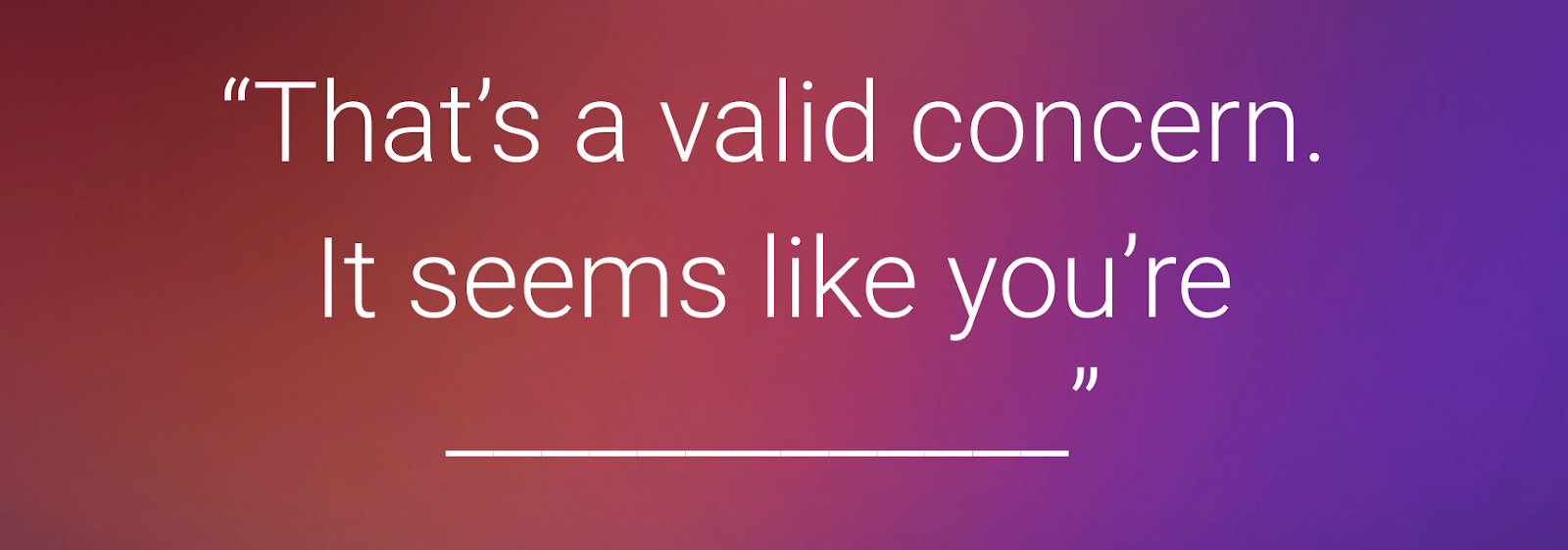
Maybe the right ending is “torn on what to do here” or “not sure how quickly you’ll see results.”
Whatever the case, the point is to offer your buyer some serious empathy. That’s a relationship builder that can’t be beaten.
Sales Tactic 13: Get Permission to Address the Objection
Once you’ve validated your buyer’s concern, you can offer up a new way of thinking.
But don’t jump in with something like “Have I got a solution for you!”
Instead,ask permissionto offer them a solution.
Most people who do that make the mistake of saying “Can I make a suggestion?”
Instead of opening a door in your buyer’s mind, that question triggers defensiveness. They’ll sayyesto be polite, but they won’t truly welcome your suggestion.
Here’s an alternate phrase that works: “Can I bounce a few thoughts off you?”
When a buyer saysyesto that, they’re psychologically open to hearing what you have to say.
Why? Because you seem vulnerable, and that’s a more comfortable space for the buyer to listen from.
Sales Tactic 14: Get Real Closure on Objections
Once you’ve presented your solution to a buyer’s objection, don’t say any of these phrases:
- Does that make sense?
- Does that solution work for you?
- Have I addressed your concern?
You may think you’re checking in with them, but there’s a good chance they won’t answer honestly. They’ll politely say “Yes, that’s fine,” when their objection could actually come back to bite you later on.
Here’s the magic phrase that brings true closure to their objection:

Say itexactlylike that and your buyer’s answer will be real and truthful. Their answer will tell you if there’s something still eating away at them, or if they’ve truly let go of their concern.
If you’like to learn more about handling objections, watch this FREE Master Class :

Sales Tactic 15: Say “Approved Pricing” (Not “List Pricing”)
This last sales tactic is an incredibly easy switch.
STOP saying “list price,” “typical price,” or “standard price”.
They’re not just ineffective phrases. They actuallywork againstyou.
Here’s the truth: Using any of those phrasesat any pointin your deal, makes your sales cycle 19% longer than average:
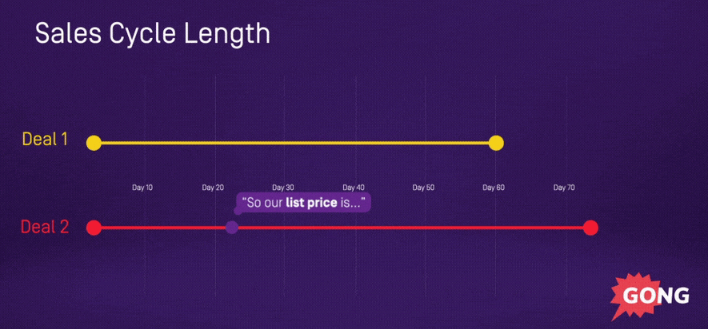
Want to add an extra 12 days to a 60-day sales cycle? I didn’t think so.
Start using these two words instead:approved price.
They have an instant effect on the buyer’s psyche because the price sounds absolutely unchangeable. As if a higher power has already considered what’s reasonable and provided a final answer.
Your buyer will instinctively know that the price won’t change easily. Few people want to negotiate in that environment. If they do, stick to your guns and they’ll have little room to maneuver.
If you’re wondering why pricing-related words and phrases are at theend of these sales tactics, read this article and download Gong’s “Pricing Cheat Sheet” . The article explains why you should talk pricing at the endof your sales process and the cheat sheet is full of the right tactics to use during those discussions:

Simple word choices have amassiveimpact on your metrics. Use the wrong ones and they’ll derail you faster than you’imagine. Use the right ones and you won’t believe how easy it is to move deals forward.
Have a winning sales tactic? One that’s your reliable go-to? We’love to hear it and why it works so well.
Give us the scoop in the comments below.

Content Author
Jil Beardmore is a content writer and editor who helps B2B tech companies communicate with clarity and impact.
She specializes in transforming complex concepts into compelling content that drives action, from executive ghostwriting to SEO optimization, ensuring marketing teams present their best selves to customers, investors, and stakeholders.
Discover more from Gong
Check out the latest product information, executive insights, and selling tips and tricks, all on the Gong blog.



